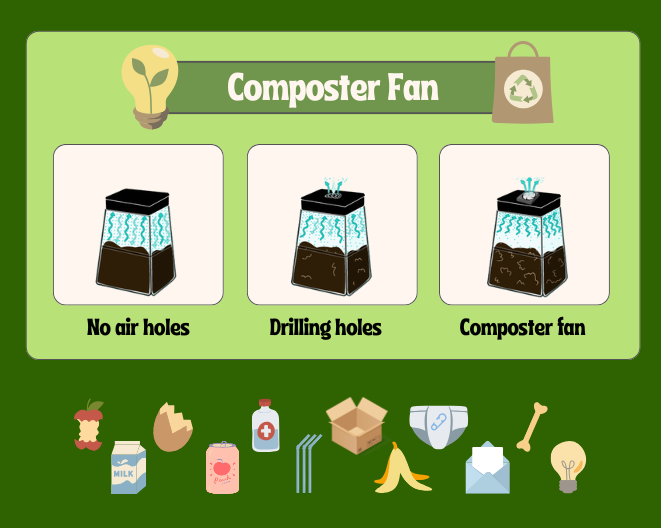Composting is an excellent approach to recycling organic waste and converting it into nutrient-dense soil for gardening and farming. However, if you’ve ever attempted composting, you’ll know that the process may need to be more active at times, especially if your compost pile lacks oxygen. A composter fan may make a significant difference in this situation. A composter fan speeds up the decomposition process by boosting aeration, allowing compost to break down more quickly and efficiently. Let’s look at how composter fans function, why they’re useful, and how you may use one to boost your composting efforts.
Also read: Abundant Harvests: Soil Health Secrets for Sustainable Farming Success!
Why Aeration is Important for Composting
In composting, microorganisms break down organic material into compost. For these microbes to thrive, they need oxygen to power the decomposition process. Without sufficient air, the compost pile can become anaerobic (without oxygen), which slows down decomposition and can cause unpleasant odors. Proper aeration allows these beneficial organisms to flourish, breaking down materials quicker and creating high-quality compost.
What is a Composter Fan?
A composter fan is a small device, often electric, designed to circulate air through a compost pile or bin. This fan ensures continuous airflow, providing oxygen to the microbes responsible for decomposition. While turning your compost manually can aerate it, a composter fan offers consistent airflow, saving you time and physical effort. These fans can be installed in various composting setups, from backyard compost bins to larger compost tumblers.
Benefits of Using a Composter Fan
- Faster Decomposition: Increased oxygen levels allow microbes to work more efficiently, speeding up the decomposition process. With a composter fan, you can produce usable compost in weeks rather than months.
- Odor Control: By encouraging aerobic decomposition, which has a much milder smell, a composter fan helps avoid the unpleasant odors that anaerobic compost piles frequently develop.
- Reduced Physical Labor: Traditional composting needs frequent turning, which may be time-consuming and labor-intensive. A composter fan reduces the need for human aeration, making it easier to manage your compost pile.
- Even Moisture Distribution: Air circulation distributes moisture more evenly throughout the pile, resulting in a perfect environment for decomposition.
- Improved Compost Quality: Better aeration results in a richer, more consistent compost product that is nutrient-dense and ready to enhance the quality of the soil.
Types of Composter Fans
There are a few different types of composter fans available, each with unique advantages:
- Electric Composter Fans: These fans are typically small and plug into an electrical outlet. They are efficient for keeping continuous airflow in a compost bin and are ideal for home composters or small-scale setups.
- Solar-Powered Fans: Solar-powered fans are eco-friendly and use energy from the sun, making them a sustainable choice. They are excellent for outdoor compost bins, especially in sunny regions.
- Battery-Operated Fans: Portable and easy to install, battery-operated fans can be used for smaller compost piles. They’re useful in areas without access to electricity but require regular battery replacement.
How to Install a Composter Fan
Setting up a composter fan is relatively simple, but it depends on your composting setup. Here’s a general guide:
- Choose a Location: Decide where the fan will be most effective. Typically, the fan should be placed near the bottom or middle of the compost bin to ensure airflow reaches the core of the pile.
- Drill Ventilation Holes: If your compost bin doesn’t already have air holes, drill a few to ensure fresh air can enter and circulate. This step is crucial for proper aeration.
- Mount the Fan: Secure the fan in place. For electric and battery-operated fans, attach it to the inside wall of the bin using screws or zip ties. Solar-powered fans may come with brackets or mounts for easier installation.
- Power Up: Connect the fan to its power source. Plug-in electric fans, install batteries for battery-powered fans or set up solar panels for solar-powered options.
- Monitor the Compost: Observe the compost’s temperature and moisture levels over time. A properly aerated pile should maintain consistent heat and moisture, signs that decomposition is proceeding efficiently.
Tips for Using a Composter Fan Effectively
- Combine with Regular Turning: While a fan reduces the need for manual turning, turning the pile occasionally can help speed up decomposition even further.
- Check Moisture Levels: Aeration can dry out the compost, so keep an eye on moisture levels and add water if needed. A balanced compost pile should feel damp but not soaked.
- Adjust Fan Speed: Some composter fans have adjustable speeds. If your compost pile is drying out, consider lowering the fan speed to reduce airflow.
- Position Strategically: If you have a larger compost bin, consider installing multiple fans or placing the fan where airflow can reach all parts of the pile effectively.
Alternatives to Composter Fans
If a composter fan isn’t feasible, there are other ways to improve aeration in your compost pile:
- Turning with a Pitchfork: Regularly turning your compost with a pitchfork is an effective way to aerate the pile, although it requires more effort.
- Adding Aerating Pipes: Some composters use PVC pipes with holes drilled into them to allow air to circulate. This can be an alternative for larger piles where a single fan might not be enough.
- Using Compost Aerators: A compost aerator is a manual tool that stirs and lifts the material, promoting airflow throughout the pile.
Must read: Potential Benefits Of Living With Organic Inputs In Agriculture
Conclusion: Is a Composter Fan Right For You?
A composter fan is a great purchase for anyone who wants to compost efficiently. Whether you’re a home gardener, a small farm owner, or an environmentally aware individual, a composter fan may save you time, increase the quality of your compost, and lessen the physical effort required for aeration. By ensuring that your compost pile receives a consistent supply of oxygen, you may produce rich, fertile compost faster than traditional techniques.
Adding a composter fan might help take your composting efforts to the next level. With the appropriate setup, a little upkeep, and the power of aeration, you can produce high-quality compost that benefits both your garden and the environment.





